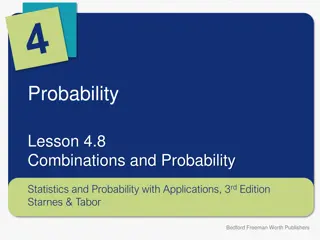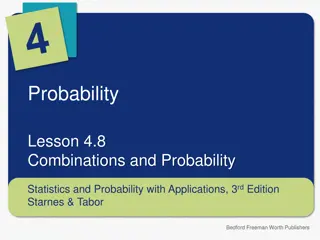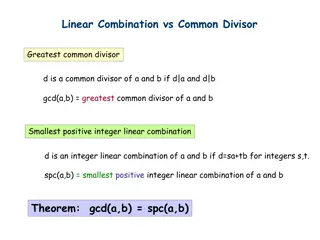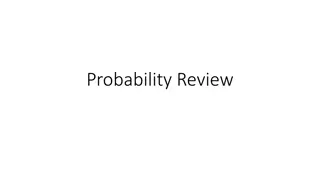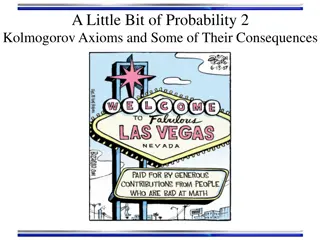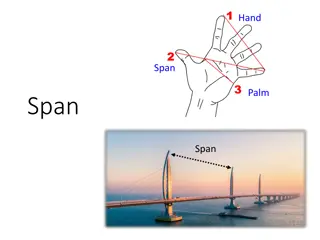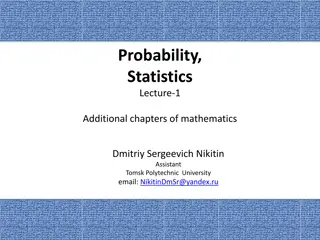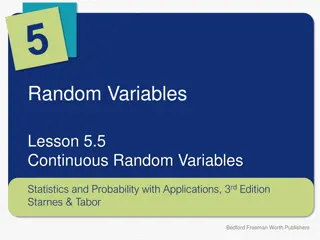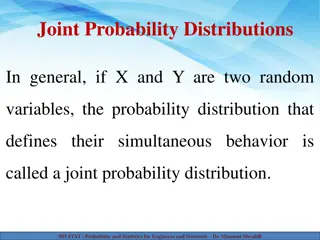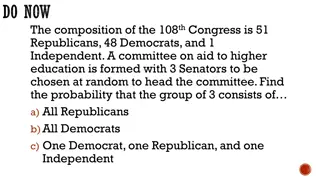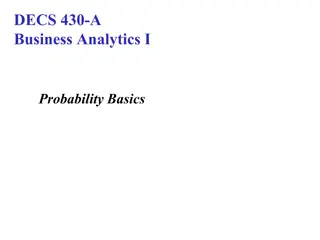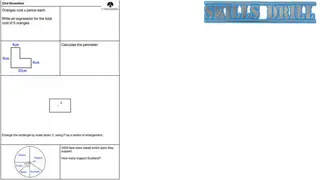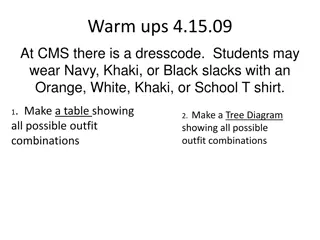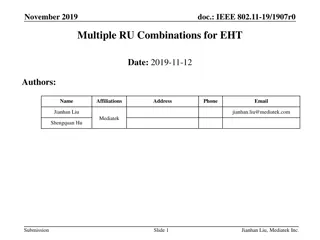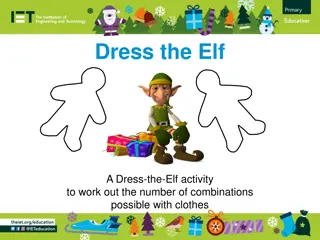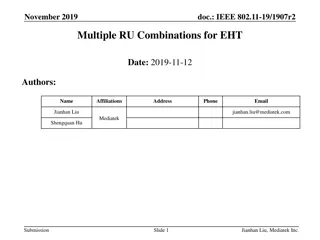Probability and Linear Combinations in Statistics
Delve into a thought-provoking journey of solving probability games and applying linear combinations in statistics. You will explore creating probability distributions, calculating expected values, and understanding the rules of linear combinations through engaging examples and practice problems. Discover how to determine average imperfections in manufactured goods and calculate probabilities using normal distributions.
Download Presentation

Please find below an Image/Link to download the presentation.
The content on the website is provided AS IS for your information and personal use only. It may not be sold, licensed, or shared on other websites without obtaining consent from the author. Download presentation by click this link. If you encounter any issues during the download, it is possible that the publisher has removed the file from their server.
E N D
Presentation Transcript
Homework (AP) Pg.378-380 #37, 55, 56(a) Agenda Warm Up Checkup Checked 10/11/18, copies Linear combinations, w/ example Practice w/ FRQ s Copies (incl. answers) Exit Pass 10 min 10 min 20 min 25 min 5 min
Warm Up Only $1 to play my game, what a deal. Let s say you toss three coins. If they re all the same, you immediately double your money! If they re not, you still might win! Pick a card. If it s a Diamond, you double your money! 1. Create a probability distribution for this game. 2. Calculate the expected value of the game.
Warm Up ANSWER Event Coins Diamond Lose same $1 $ $1 -$1 P 6 13 3 9 2 = 8 8 52 16 16 2 3 9 + + = . 0 125 8 16 16
Example #1 You work for a company that manufactures refrigerators, and you are examining surface flaws , such as dimples and paint chips. You find that your company s refrigerators have a mean 0.7 dimples, with =0.11, and a mean 1.4 paint chips, with =0.2. The distributions of both dimples and paint chips are Normally distributed. 1. What is the average number of imperfections on a refrigerator? 2. What is the standard deviation of your answer to #1? 3. What is the probability that a randomly selected refrigerator has less than 2 surface flaws?
Notes Linear Combinations: 3 Rules 1 of 2 1. The average of both random variables is the sum of each of their averages. Works whether or not X and Y are independent. x+y = x + y x-y = x - y 2. The standard deviation of both random variables is the square root of the sum of their variances. Only works if X and Y are independent. x+y= x2+ y2 x-y= x2+ y2 3. Any linear combination of normally distributed random variables is also normally distributed.
Example #1 You work for a company that manufactures refrigerators, and you are examining surface flaws , such as dimples and paint chips. You find that your company s refrigerators have a mean 0.7 dimples, with =0.11, and a mean 1.4 paint chips, with =0.2. The distributions of both dimples and paint chips are Normally distributed. 1. What is the average number of imperfections on a refrigerator? 2. What is the standard deviation of your answer to #1? 3. What is the probability that a randomly selected refrigerator has less than 2 surface flaws?
Example #1 ANSWERS You work for a company that manufactures refrigerators, and you are examining surface flaws , such as dimples and paint chips. You find that your company s refrigerators have a mean 0.7 dimples, with =0.11, and a mean 1.4 paint chips, with =0.2. The distributions of both dimples and paint chips are Normally distributed. 1. What is the average number of imperfections on a refrigerator? 1 . 2 4 . 1 7 . 0 = + 2. What is the standard deviation of your answer? 2 . 0 + = 2 2 . 0 11 . 0 228 1 . 2 2 = . 0 44 3. refrigerator has less than 2 surface flaws? What is the probability that a . 0 228 . 0 33
Notes Linear Combinations: Example #2 2 of 2 Mr. Starnes likes sugar in his hot tea. From experience, he needs between 8.5 and 9 grams of sugar in a cup of tea for the drink to taste right. While making his tea one morning, Mr. Starnes adds four randomly selected packets of sugar. Suppose the amount of sugar in these packets (of the same brand) follows a Normal distribution with mean 2.17 gramsand standard deviation 0.08 grams. What is the probability that Mr. Starnes cup of tea will taste right? . 2 17 . 2 17 . 2 17 . 2 + + + = 17 . 8 68 MEAN: + + + = 2 2 2 2 . 0 08 . 0 08 . 0 08 . 0 08 . 0 16 STANDARD DEVIATION: . 8 5 . 8 68 . 8 9 68 = . 1 125 = 2 . 0 16 . 0 16 1292 . 0 = 9772 . 0 . 0 848
You try 1. WINDOW. The owner of a coffee shop, an amateur statistician, advertises that the price of coffee on any given day will be randomly picked using a normal distribution with mean $1.35 and standard deviation $0.10. If a customer buys a cup of coffee for 10 days, and each price is independent, what is the probability that he will pay a total exceeding $14.00? 2. DOOR. Last semester, my students averaged 78.2% on this upcoming quiz, with a standard deviation of 8.95%. If three randomly selected students are selected, what is the probability that they average at least a B? Hint: Their sum must be at least 240%.
Window ANSWER The owner of a coffee shop, an amateur statistician, advertises that the price of coffee on any given day will be randomly picked using a mean of $1.35 and standard deviation $0.10. If a customer buys a cup of coffee for 10 days, and each price is independent, what is the probability that he will pay a total exceeding $14.00? MEAN: . 1 35 . 1 + . 1 + . 1 + . 1 + . 1 + . 1 + . 1 + . 1 + . 1 + = 35 35 35 35 35 35 35 35 35 13 5 . STANDARD DEVIATION: 1 . + 14 1 . + 13 1 . + 1 . + 1 . + 1 . + 1 . + 1 . + 1 . + = 2 2 2 2 2 2 2 2 2 2 1 . . 0 316 5 . 9429 . 0 = . 1 = 1 0571 . 0 58 . 0 316
Door ANSWER Last semester, my students averaged 78.2% on this upcoming quiz, with a standard deviation of 8.95%. If three randomly selected students are selected, what is the probability that they average at least a B? Hint: Their sum must be at least 240%. + + = . 0 782 . 0 782 . 0 782 . 2 346 MEAN: + + = 2 2 2 0895 . 0895 . 0895 . . 0 155 STANDARD DEVIATION: . 2 40 . 2 346 = . 0 35 . 0 155 6368 . 0 = 1 3632 . 0
FRQ Practice -- linear combinations I will give you two problems, Window and Door. You may write on the copies.
DOOR (FRQ 2002, #3) The team has 4 runners. They are going to compete in a race, and each runner will run a mile. The team time is the sum of individual times for all 4 runners. Assume individual runner times are independent. The individual times (min.) of the runners in similar races are approximately normally distributed, with these means and standard deviations. Mean Runner 1 4.9 0.15 Runner 2 4.7 0.16 Runner 3 4.5 0.14 Runner 4 4.8 0.15 a. Runner 3 thinks he can run a mile in less than 4.2 minutes in the next race. Is this likely? Explain. b. The distribution of possible team times is approximately normal. What are the mean and standard deviation of this distribution? c. Suppose the team s best time to date is 18.4 minutes. What is the probability that the team will beat its own best time in the next race?
WINDOW Suppose men s weights (in pounds) are normal with a mean of 170 and a standard deviation of 40 lb., and women s weights are also normal but with a mean of 135 and a standard deviation of 30 lb. 1. If a man and woman are selected at random . a. What is the probability that the sum of their weights is at least 300 pounds? b. What is the probability that their total weight is at most 320 pounds? c. (Optional, difficult) What is the probability that the woman is heavier than the man? 2. If you were to select 3 men at random, what is the probability that the sum of their weights is at least 500 pounds?
DOOR (FRQ 2002, #3) ANSWERS Mean Runner 1 4.9 0.15 a. Runner 3 thinks he can run a mile in less than 4.2 minutes in the next race. Is this likely? Explain. 2 . 4 Runner 2 4.7 0.16 Runner 3 4.5 0.14 5 . 4 Runner 4 0162 . 0 4.8 0.15 = . 2 14 . 0 14 b. The distribution of possible team times is approximately normal. What are the mean and standard deviation of this distribution? 7 . 4 + 5 . 4 + 8 . 4 + = 9 . 4 18 9 . + + + = 2 2 2 2 15 . 16 . 14 . 15 . 3003 . 0 c. Suppose the team s best time to date is 18.4 minutes. What is the probability that the team will beat its own best time in the next race? 18 4 . 18 9 . = . 1 67 3003 . 0 0475 . 0
WINDOW ANSWERS Men: mean of 170, standard deviation of 40 lb. Women: mean of 135, standard deviation of 30 lb. a) What is the probability that the sum of their weights is at least 300 pounds? 5398 . 0 300 305 1 . 0 6179 . 0 = 50 b) What is the probability that their total weight is at most 320 pounds? 320 305 = 3 . 0 50 35 c) (Optional, difficult) What is the probability that the woman is heavier than the man? 0 7 . 0 2420 . 0 = 50 2. the probability that the sum of their weights is at least 500 pounds? If you were to select 3 men at random, what is 500 510 . 0 5557 . 0 = 144 69 28 .
No sharp darts No latex balloons Careful w/ food Casino Project ideas Good Great One-of-a-kind ? I m confused, or don t have enough information. B Extra credit. Requires binomial probability. We ll learn this next Tuesday. C Stay after class today or Monday to learn. Extra credit. Requires confidence intervals. We ll learn this next month. It s time-consuming.
Casino Project (AP) Create, mathematically analyze, and run a simple gambling game which is significantly (but not obviously) in favor of you, The House . 1-2 people (2 recommended) Up to +5% extra credit for binomial probabilities and/or confidence intervals. Monday March 9th, due end of class: 1. List three possible ideas for your project. For each game, state how to play and how to win. Wednesday March 18th (or earlier), due end of class: 2. Choose one game and give it a catchy name. Describe your game (including the title), and calculate its probabilities and expected value. Tuesday March 24th: 3. Bring an attractive poster that explains your game, including prices and prizes. Bring all components needed for your game. Thursday March 26th: CASINO DAY! 7. Run your game, attract gamblers, and help them lose their money! You must profit at least $500 ($1000 total).
Homework (AP) Pg.378-380 #37, 55, 56(a) tinyurl.com/Colligan-may-2020 Exit Pass (AP) You have two balanced six-sided dice. The first has 1, 3, 4, 5, 6, and 8 spots on its six faces. The second die has 1, 2, 2, 3, 3, and 4 spots on its faces. 1. Find the probability model for the sum of the spots on the up-faces of the two dice. 2. Let s say you pay $1 to roll these dice, and if your sum is greater than 8, you double your money! Calculate the expected value.
1,1 1,2 1,2 1,3 1,3 1,4 3,1 3,2 3,2 3,3 3,3 3,4 4,1 4,2 4,2 4,3 4,3 4,4 5,1 5,2 5,2 5,3 5,3 5,4 6,1 6,2 6,2 6,3 6,3 6,4 8,1 8,2 8.2 8,3 8,3 8,4 Exit Pass (AP) ANSWER 1, 3, 4, 5, 6, and 8 spots. 1, 2, 2, 3, 3, and 4 spots. 2 3 4 5 6 7 8 9 10 11 12 4 3 2 4 5 6 2 1 1 5 3 36 36 36 36 36 36 36 36 36 36 36 $1 $-1 10 26 36 36


